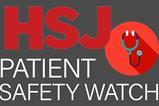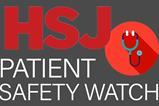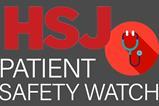HSJ is now hosting the Patient Safety Watch newsletter, written by Patient Safety Watch chief executive James Titcombe.
Good afternoon and welcome to our first newsletter of 2024.
Strikes spark patient safety fears
As we start 2024, the junior doctors’ strike (taking place for six days from 3 January) has been in the headlines. The Guardian has reported on NHS leaders’ fears that “patient safety could be compromised… if medics do not honour an agreement to abandon picket lines if hospitals become overwhelmed during the winter crisis”.
According to the newspaper, a senior NHS official has raised concerns about possible disagreements over how serious an incident needed to be before a request to recall staff would be approved.
Meanwhile, BBC News reported that struggling NHS services have made more than 20 requests for striking junior doctors to return to work but the British Medical Association had not granted any of the requests made on the first day of the strike at the time the story was published.
The broadcaster said the union felt NHS bosses were misusing the derogation system while NHS England stressed the requests were genuine.
There are two sides to every story and this newsletter will avoid making judgements as to the rights and wrongs of the dispute. However, the links between a cared-for and valued workforce and patient safety are clear. In a pressured NHS, it’s often goodwill and staff going above and beyond that makes the difference between good care and a poor experience.
A dispute between such an important part of the NHS workforce and the government as well as industrial action at such a pressured time for the NHS is bad news for everyone. There can be little doubt that patients and families – sometimes in very vulnerable positions – will suffer a detrimental impact.
In the short term, an urgent solution is needed to end the current dispute but in the longer term, it’s also clear that more needs to be done to ensure the whole NHS workforce feels valued, cared for and better supported. Doing so isn’t just the right thing to do for staff – it’s also a patient safety imperative.
In other news this edition:
IT errors are a patient safety issue, says watchdog
In an interview with BBC News, Health Services Safety Investigations Body interim chief investigator Rosie Benneyworth said the watchdog had seen evidence of computer errors leading to patient deaths and called for urgent action.
She gave examples of one patient who was found in an unresponsive condition and then wrongly identified as not wishing to be resuscitated, and another who died 18 days after they were given the wrong medications due to a mix-up in their electronic notes.
Dr Benneyworth added: “We need to see much faster action in this area so that patients don’t come to any further harm.”
Meanwhile, HSSIB senior safety investigator Helen Jones wrote in a blog post last month that the watchdog had seen various reoccurring problems with electronic patient records “if they are launched or used without a proactive view on their safety”.
Warning raised about interaction between painkiller and blood thinner
As reported by The Pharmaceutical Journal, a coroner has written to NHSE to urge it to raise awareness following a death caused by the interaction between painkiller tramadol and blood thinner warfarin.
Susan Gladstone died in 2021 following a bleed on the brain. Her inquest concluded she “died as a result of a generally unknown interaction between warfarin and tramadol, which caused exceptional thinning of her blood”.
Graham Danbury, assistant coroner for Hertfordshire, warned warfarin’s interaction with tramadol was not listed under the opioids known reactions in the British National Formulary, adding: “There was nothing to warn the prescribing doctor of any possible interaction. I found on the balance of probabilities that an interaction between tramadol and warfarin had caused this dangerous, and in the event, fatal [blood clotting test result] to develop.”
Nurse’s sentencing hearing shines light on whistleblower’s bravery
This newsletter has previously covered nurse Catherine Hudson’s conviction for giving two patients unprescribed sedatives in 2017 and 2018 at Blackpool Victoria Hospital. She was also found guilty of conspiring with colleague Charlotte Wilmot to give a sedative to a third patient.
In December, Ms Hudson was sentenced to seven years and two months in prison, while Ms Wilmot received a three-year sentence.
BBC News reported how, during the sentencing hearing, the son of one of Ms Hudson’s victims said: “The way you spoke about patients is beyond belief and nothing short of wicked and pure evil. Thanks to the bravery of a student nurse [who blew the whistle after witnessing the events] in highlighting you and your evil and uncaring ways, it has most likely saved my mum’s life.”
The judge also praised the whistleblower’s actions, adding: “It was only as a result of her courage and sense of public duty that what was happening on the ward was exposed and stopped.”
Global State of Patient Safety report published
Here at Patient Safety Watch, we had a busy end to 2023, with the publication of our second major research report, launched in the House of Lords on 11 December.
The report, Global State of Patient Safety 2023, provides insight into the current state of patient safety around the world, through analysis of publicly available data from the last two decades.
Produced by the Institute of Global Health Innovation at Imperial College London, and commissioned by Patient Safety Watch, the report includes for the first time a user-friendly interactive data dashboard, case studies of patient safety excellence from around the world and a ranking of patient safety in OECD countries.
The patient safety country ranking compares the performance of OECD countries across four well-established patient safety indicators, following the methodology used by the Commonwealth Fund. Using this approach, the UK ranks 21 out of 38 countries and could have had 17,356 fewer deaths annually had it performed at the level of the top decile of OECD countries.
You can read more about the report in coverage from the Independent, Daily Mail, The Times and Telegraph. The free-to-access global data dashboard is available here.
Sharing some good stuff
What are the features of high-performing quality improvement collaboratives?
This paper, published in the BMJ, offers valuable learning for optimising collaboration-based approaches to improvement in healthcare and will be useful to clinicians, managers, policymakers, and health system leaders engaged in multi-organisational approaches to improving quality and safety.
The paper identifies five features that characterised success in the collaborative programme: learning from positive deviance; high-quality coordination; high-quality measurement and comparative performance feedback; careful use of motivational levers; and mobilising professional leadership and building community.
When I read the paper, I thought of its applicability to improving quality and safety across maternity services (a problem which regularly appears in these newsletters), particularly how these features align with schemes such as the National Maternity Safety Support Programme which is currently being reviewed – so very timely indeed!
Thanks all for this edition. Thanks for reading and wishing all our readers a very Happy New Year and all the best for a safe 2024. Please look out for our next newsletter in two weeks’ time.
James Titcombe
































No comments yet